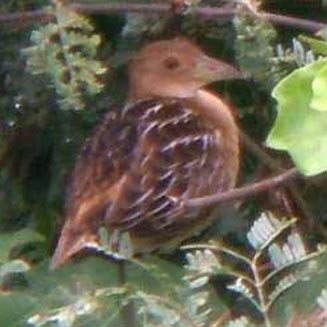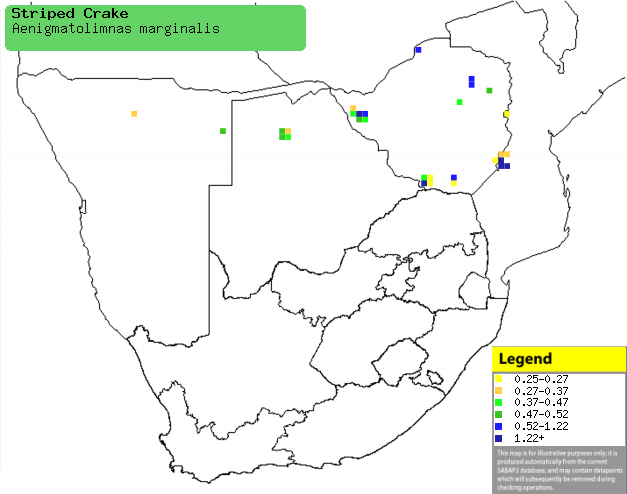|
Aenigmatolimnas marginalis
(Striped crake)
Gestreepte riethaan [Afrikaans]; Afrikaans porseleinhoen
[Dutch]; Marouette rayée [French]; Graukehl-sumpfhuhn [German];
Franga-d'água-estriada [Portuguese]
Life
> Eukaryotes >
Opisthokonta
> Metazoa (animals) >
Bilateria >
Deuterostomia > Chordata >
Craniata > Vertebrata (vertebrates) > Gnathostomata (jawed
vertebrates) > Teleostomi (teleost fish) > Osteichthyes (bony fish) > Class:
Sarcopterygii (lobe-finned
fish) > Stegocephalia (terrestrial
vertebrates) > Tetrapoda
(four-legged vertebrates) > Reptiliomorpha > Amniota >
Reptilia (reptiles) >
Romeriida > Diapsida > Archosauromorpha > Archosauria >
Dinosauria
(dinosaurs) > Saurischia > Theropoda (bipedal predatory dinosaurs) >
Coelurosauria > Maniraptora > Aves
(birds) >
Order: Gruiformes > Family: Rallidae
 |
|
|
Striped crake, along the Levhuvu River near Pafuri
in the Kruger National Park. [photo Geoff Lockwood
©] |
|
Distribution and habitat
Occurs patchily in West Africa and the area from
Uganda, Kenya and eastern DRC south through Tanzania, Malawi, Zambia and
northern Mozambique to southern Africa. Here it is only common at Harare
(Zimbabwe), while more scarce elsewhere in Zimbabwe, in northern Botswana,
west-central Mozambique and northern Namibia. It generally prefers seasonally
inundated grassland with marsh grasses, such as Golden timothy grass (Setaria
sphacelata), Swamp cut grass (Leersia hexandra), Cat's tail grass (Sporobolus
pyramidalis) and Weeping love-grass (Eragrostis curvula).
|
 |
|
Distribution of Striped crake in southern Africa,
based on statistical smoothing of the records from first SA Bird Atlas
Project (©
Animal Demography unit, University of
Cape Town; smoothing by Birgit Erni and Francesca Little). Colours range
from dark blue (most common) through to yellow (least common).
See here for the latest distribution
from the SABAP2. |
Predators and parasites
Movements and migrations
Intra-African breeding migrant, breeding in
southern Africa from December-May, probably heading in the
non-breeding season to equatorial Africa.
Food
Its diets consists of invertebrates, small fish and
tadpoles, doing most of its foraging from late afternoon to dusk on muddy ground
or water-lilies, probing and pecking in search of food. The following food items have been recorded
in its diet:
- Invertebrates
- insects
-
spiders
- small snails
- earthworms
- Vertebrates
Breeding
- Its breeding habits are complex, as it is thought to be mainly
sequentially polyandrous, meaning that each female mates with multiple
males. Once the egg is laid, the female takes no further part in the
incubation of the eggs and the rearing of the brood.
- The nest is a small saucer-shaped structure, built of dry grass and
concealed in a grass tuft, especially Gongoni three-awn grass (Aristida
junciformis), Swamp cut grass (Leersia hexandra), Golden timothy
grass (Setaria sphacelata), Cat's-tail grass (Sporobolus
pyrmidalus), Weeping love-grass (Eragrostis curvula) and Vasey
grass (Paspalum urvillei).
- Egg-laying season is from December-March.
- It lays 3-5 eggs, which are incubated solely by the female for about
17-18 days (recorded in captivity).
- The chicks leave the nest with the male at about 4-5 days old, taking their first flight at about 46-53 days old.
Threats
Status uncertain; it is thought to be threatened by human
disturbance while breeding, wetland drainage, river damming and overgrazing.
References
-
Hockey PAR, Dean WRJ and Ryan PG 2005. Roberts
- Birds of southern Africa, VIIth ed. The Trustees of the John Voelcker
Bird Book Fund, Cape Town.
|
